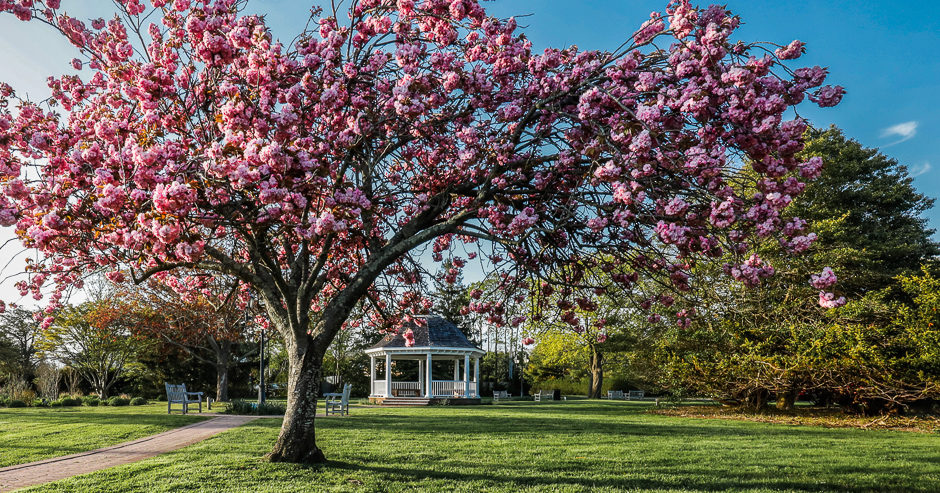
Westhampton Beach Village Green, May 5, 2019
—————————–
WESTHAMPTON BEACH WALKING TOUR
North to South Main Street / West Side
Note that Main Street is currently under construction.
Copy courtesy of the Westhampton Beach Historical Society.
~~~~~~~~~~~~~~~~~~~~~~~~~~~~~~~~~~~~~~~~~
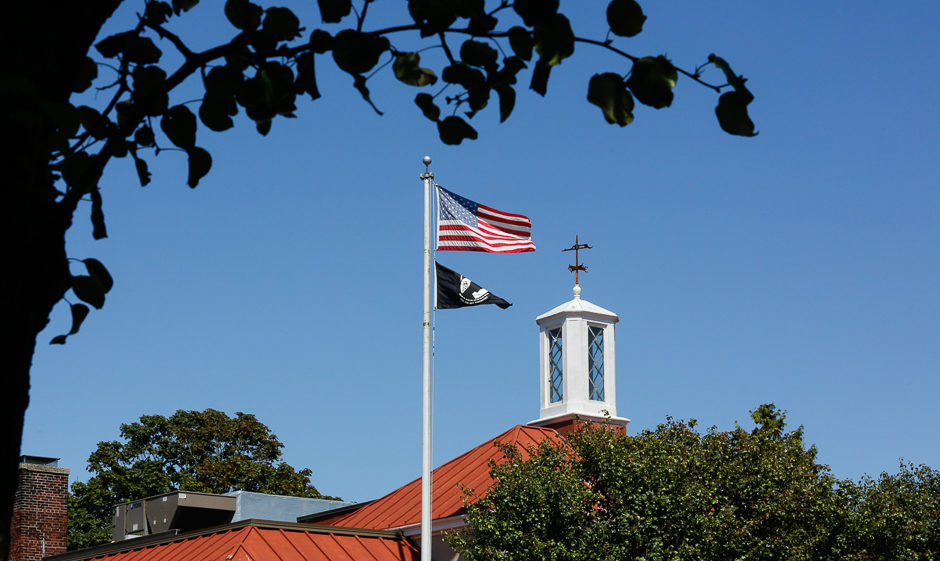
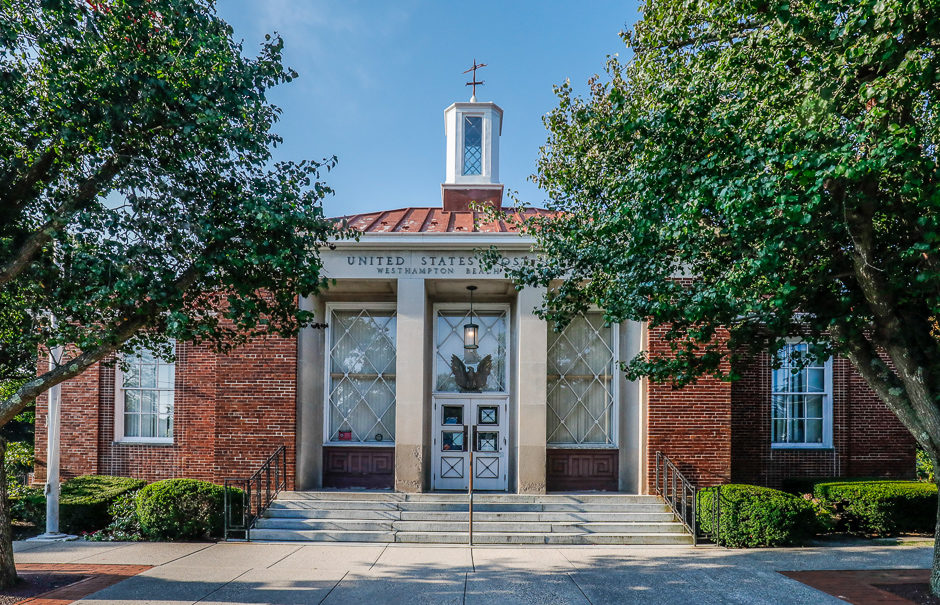
United States Post Office, 1940, Westhampton Beach. Louis A. Simon, Architect (Supervising Architect of the Treasury Department)
This building, which is listed on the National Register of Historic Places, was designed by Louis A. Simon, Supervising Architect of the Treasury Department, and is an intact example of federal architecture initiated by the U.S. government during the Great Depression of the 1930s. Completed in 1940, the building was designed in an austere version of the Colonial Revival style, with simplified classical forms. Of interest, inside to the right of the entry is a mural entitled “Outdoor Sports” painted by Sol Wilson in 1942. Mr. Wilson emigrated from Poland in 1911 and painted for the U.S. Treasury Department’s Section of Fine Arts. — Westhampton Beach Historical Society.
National Register of Historic Places.

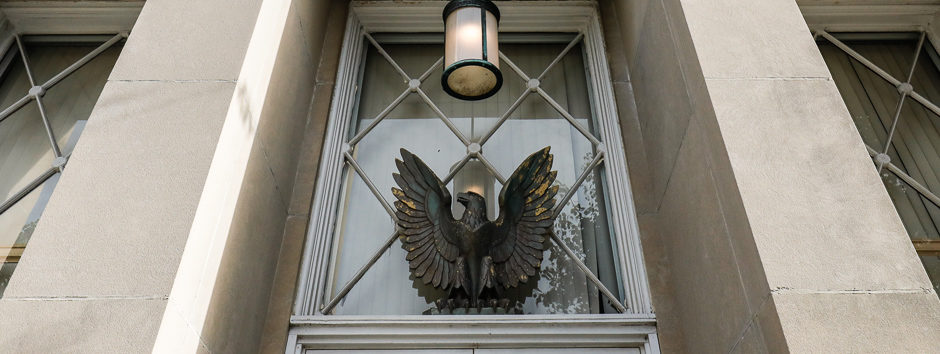
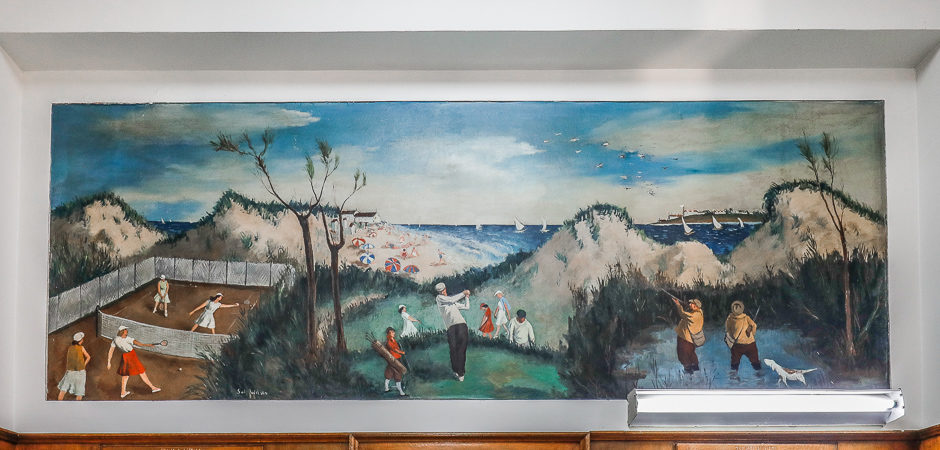
“Outdoor Sports” by Sol Wilson, 1942, in the Westhampton Beach Post Office lobby.

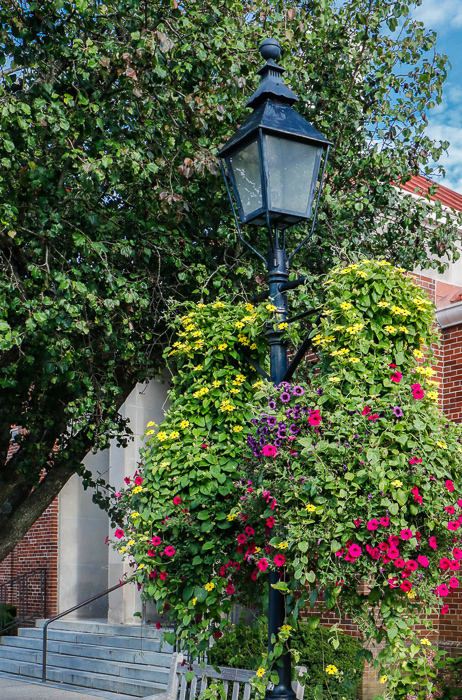
~~~~~~~~~~~~~~~~~~~~~~~~~~~~~~~~~~~~~~~~~
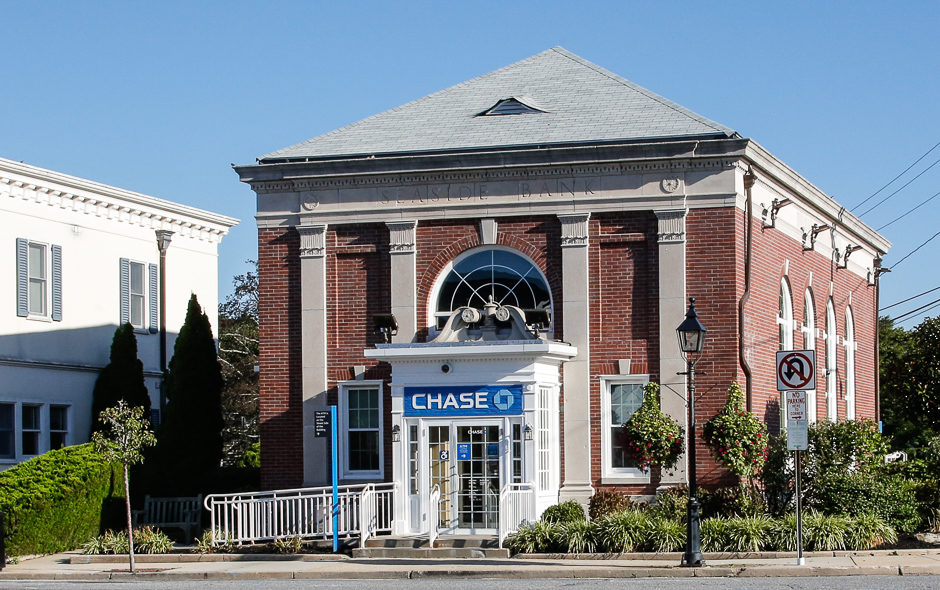
Seaside Bank Building
Constructed in 1925 for the Seaside Bank, a local bank founded in 1904 by a group of Quogue and Westhampton Beach businessmen, this bank building exhibits distinctive Renaissance-inspired details, including Corinthian-style columns on the front facade and highly decorative molding beneath the roofline. Although it now features a front vestibule addition that obscures some of its original architecture, this handsome brink building remains a tangible reminder of the ambitions and prosperity of its era. — WHB Historical Society.

~~~~~~~~~~~~~~~~~~~~~~~~~~~~~~~~~~~~~~~~~
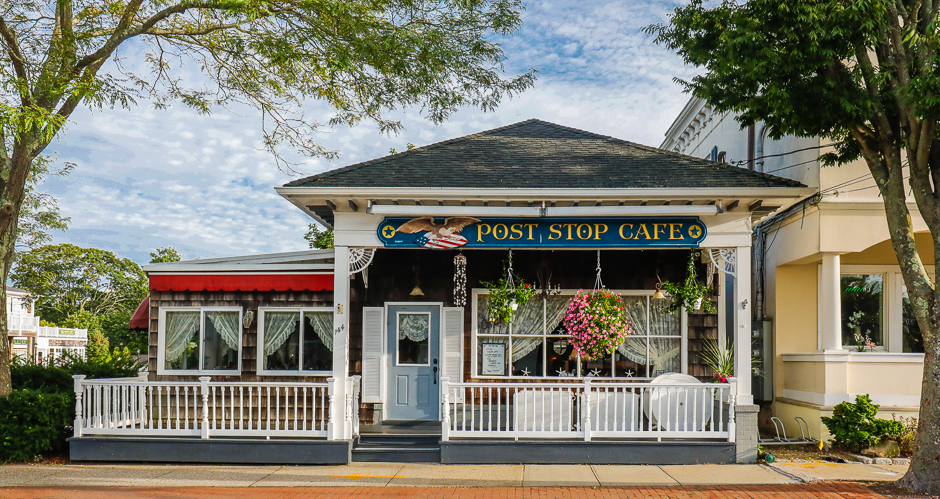
Former Post Office
Constructed in 1914 by E.H. Bishop, the main portion of this building was rented to the U.S. Postal Service and operated as a post office until 1940, when the current post office was opened. Thereafter, it was operated as Straw’s Stationary Store until the 1950s and as Cobb’s Luncheonette until the 1970s. It continues today as the Post Stop Cafe. — WHB Historical Society.
~~~~~~~~~~~~~~~~~~~~~~~~~~~~~~~~~~~~~~~~~
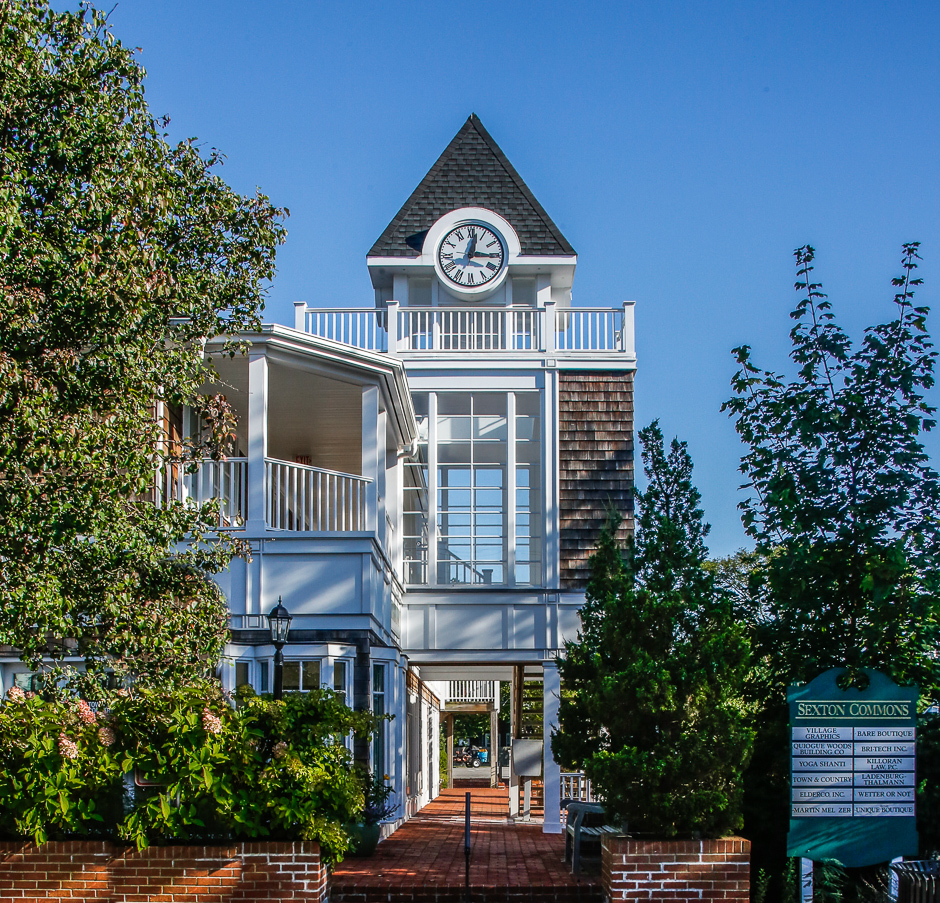
Bishop, Newins, Sextons Building
This building is reported to include the former 1880 E.H. Bishop store, moved to this location about 1902. Mr. Bishop continued operating his general store here until about 1924 when it was purchased by Wilfred Newins, who continued operating a dry goods store until 1951 when Daniel Brown purchased the business. Mr. Brown expanded the business and the building and sold them to Bill and Peggy Sexton in 1970. The Sextons continued operations until 1985 when, in a major renovation they divided the building into multiple units. Although the building now exhibits few historic features, the ghost of the 1880s general store may still be present! — WHB Historical Society.
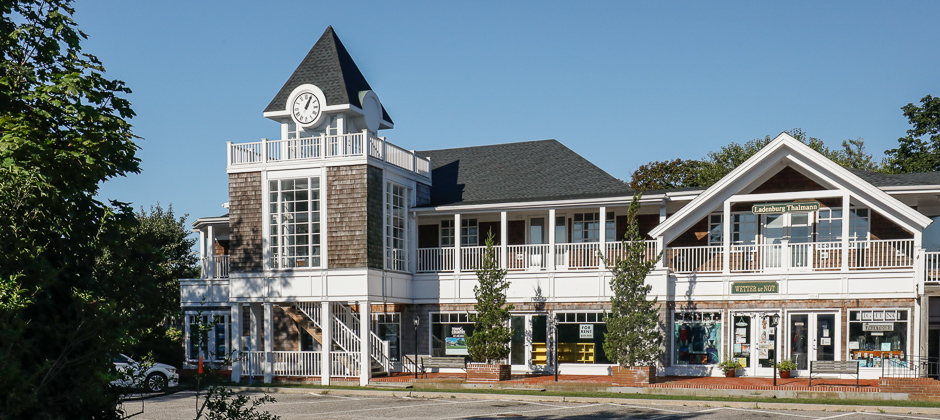
~~~~~~~~~~~~~~~~~~~~~~~~~~~~~~~~~~~~~~~~~

Ria Dell Bene Memorial Playground off parking area behind the Sexton’s building.
~~~~~~~~~~~~~~~~~~~~~~~~~~~~~~~~~~~~~~~~~
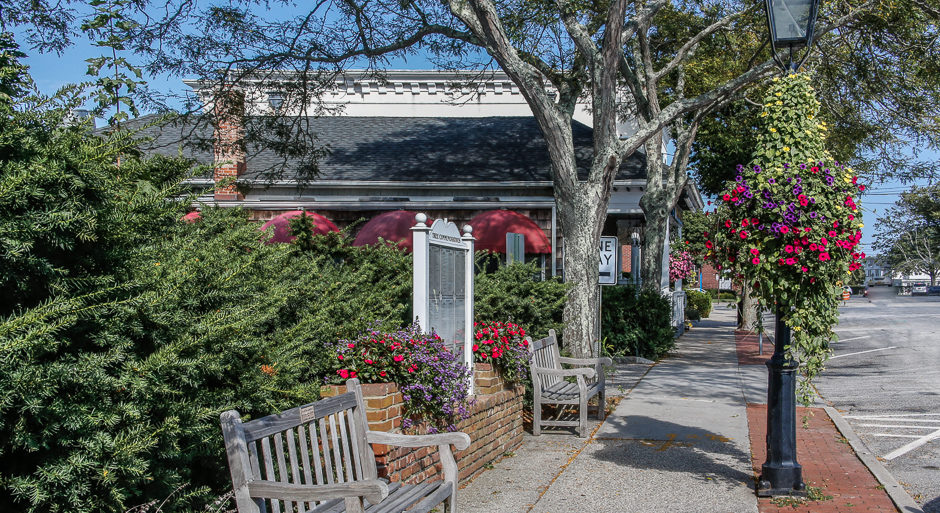
Main Street looking toward Post Office Cafe.
~~~~~~~~~~~~~~~~~~~~~~~~~~~~~~~~~~~~~~~~~

Grimshaw and Redfield building
The Grimshaw and Redfield building dates to 1896 and looking nearly the same as in early photos, with distinctive bay windows, porch railings and recessed entries. A one-time location of the Ketchaponack Post Office (1909-1914), this building was also home to Larabee Dry Goods, Grimshaw & Redfield Plumbing and Hardware, and the Hampton Chronicle (now Southampton Press) from 1907 to 1925. — WHB Historical Society.
~~~~~~~~~~~~~~~~~~~~~~~~~~~~~~~~~~~~~~~~~
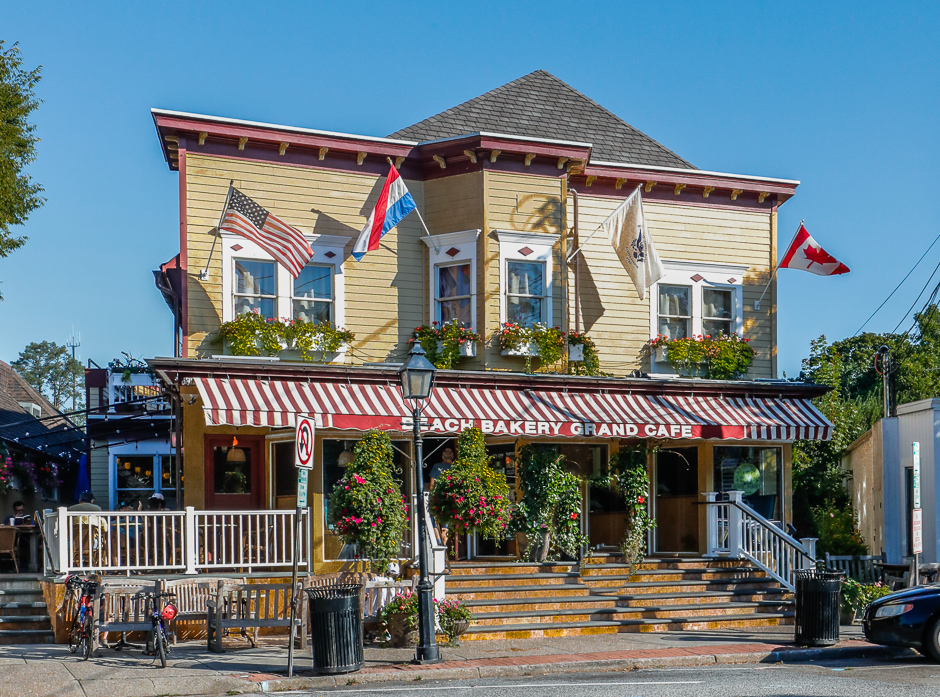
Seeley Building
Purchased in 1904 by James and Angelina Seeley, who lived upstairs with their six children and operated a general store on the first floor, which was elevated above street level to avoid occasional floods from Monibogue Creek (aka Aunt Harriet’s Crick). Gloria Seeley, the youngest child, took over the family business in the 1930s and ran it until the 1980s, after which the building was converted to a bakery. Although the building was expanded and modernized, the appearance of the front facade was largely retained. — WHB Historical Society.

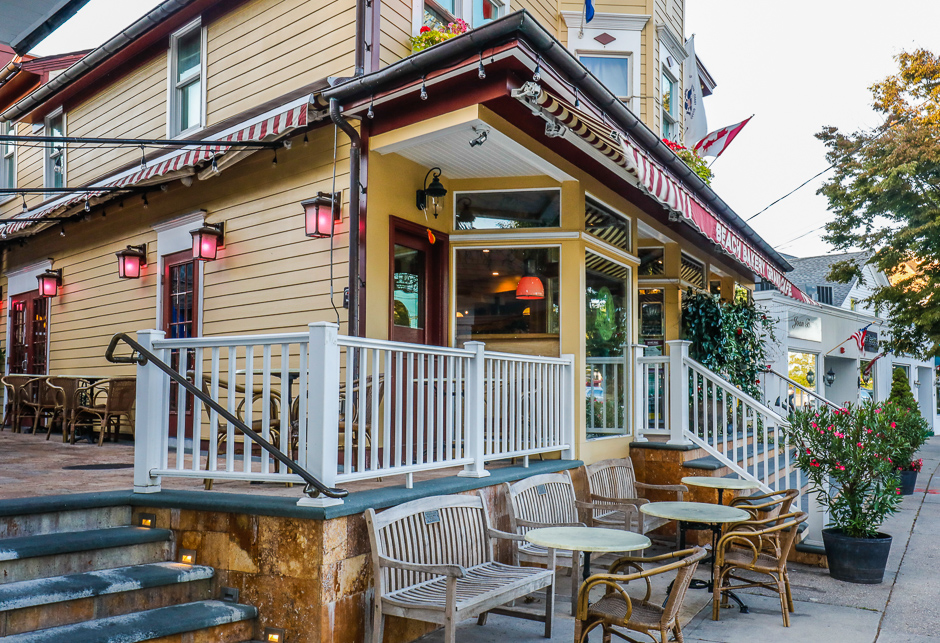
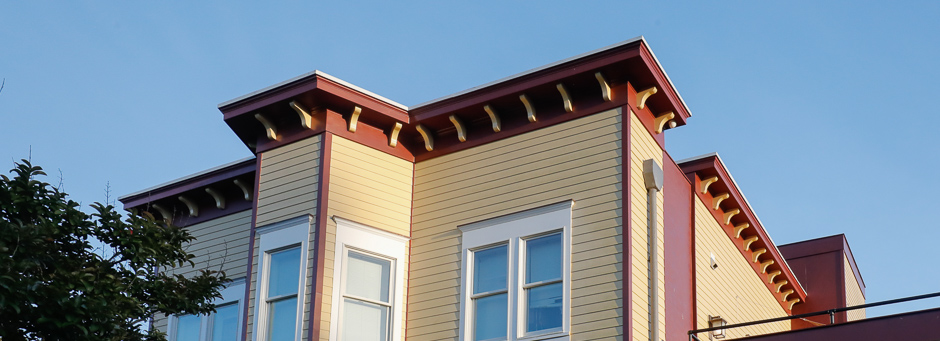
~~~~~~~~~~~~~~~~~~~~~~~~~~~~~~~~~~~~~~~~~
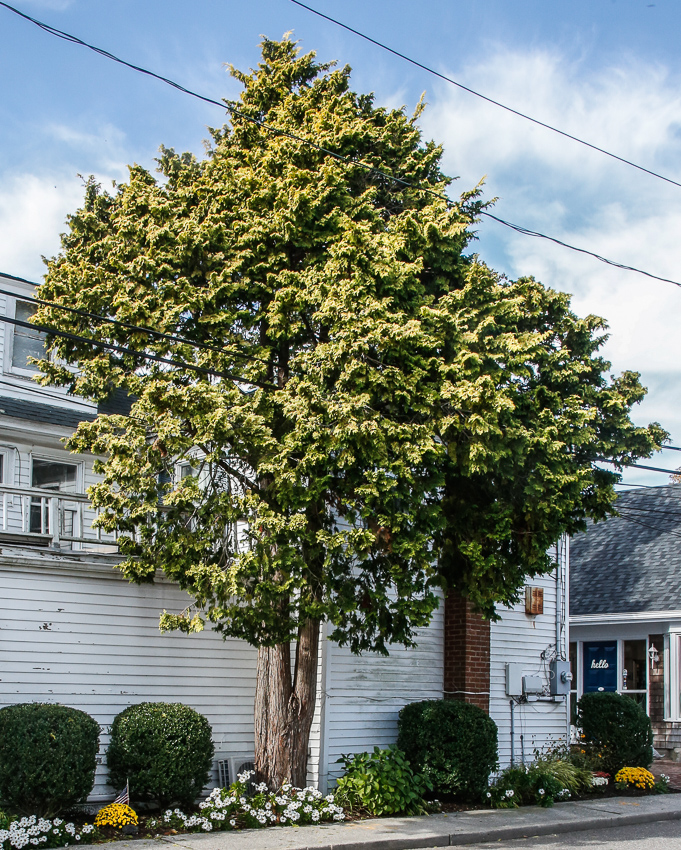
Golden False Cypress
A slow-growing ornamental evergreen with golden-yellow thread foliage. Westhampton Beach Tree Walk*
~~~~~~~~~~~~~~~~~~~~~~~~~~~~~~~~~~~~~~~~~

Daniel Egbert Smith Building
This building anchors the northwest corner of Main Street and Glovers Lane and was moved to this location by George Jagger in the late 1800s. D. Egbert Smith established his store here around 1900 and sold ice cream, cake, fruits and vegetables, butter, and eggs until 1940. Although the first floor has been modified, the building retains much of its historic character. — WHB Historical Society.
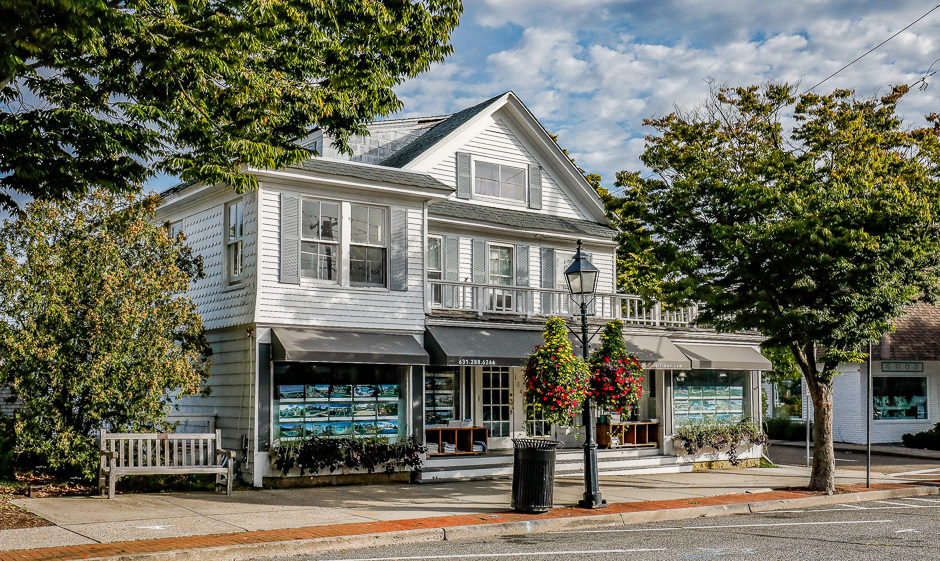
~~~~~~~~~~~~~~~~~~~~~~~~~~~~~~~~~~~~~~~~~

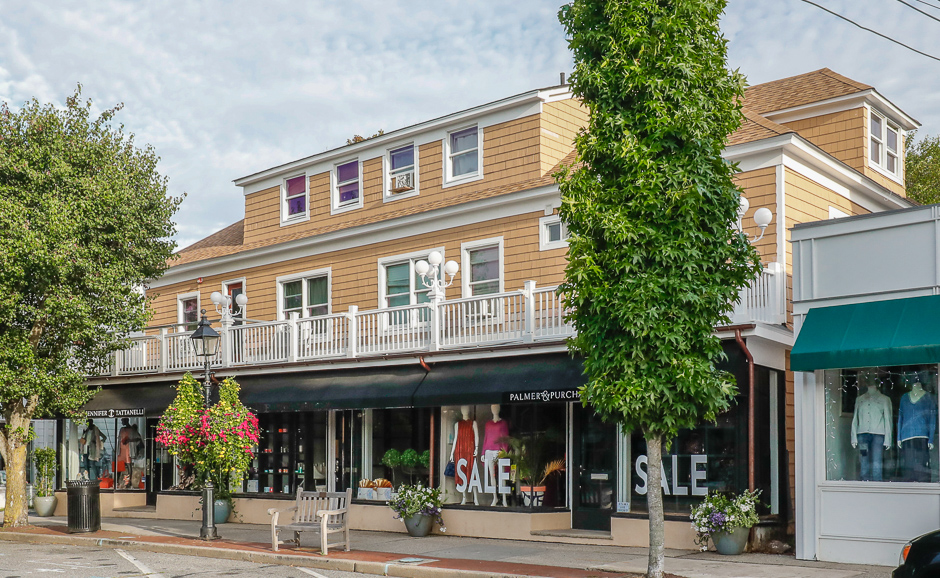
Platt / Schwartz Building
Constructed by Henry Platt in the early 1900s using a barn formerly owned by Ernest Bishop. Mr. Platt operated a clothing and dry goods store here until about 1930, when he sold it to Herbert N. Schwartz. The Schwartz family and relatives continued operating a clothing and dry goods store here until 1982. — WHB Historical Society.
~~~~~~~~~~~~~~~~~~~~~~~~~~~~~~~~~~~~~~~~~

Westhampton Beach Performing Arts Center
Originally, The Main Street Theater, constructed by the Heelbarp Corporation and operated by the Prudential Company as the Westhampton Theater (now WHBPAC). It opened in June, 1932, with NYS Governor Alfred E. Smith attending and operated as a movie theater until 1996. Its facade features Greek Revival elements that were maintained during the building’s 1998 renovation and expansion. The interior was also reconstructed and now reflects the heater’s historic past. — WHB Historical Society.
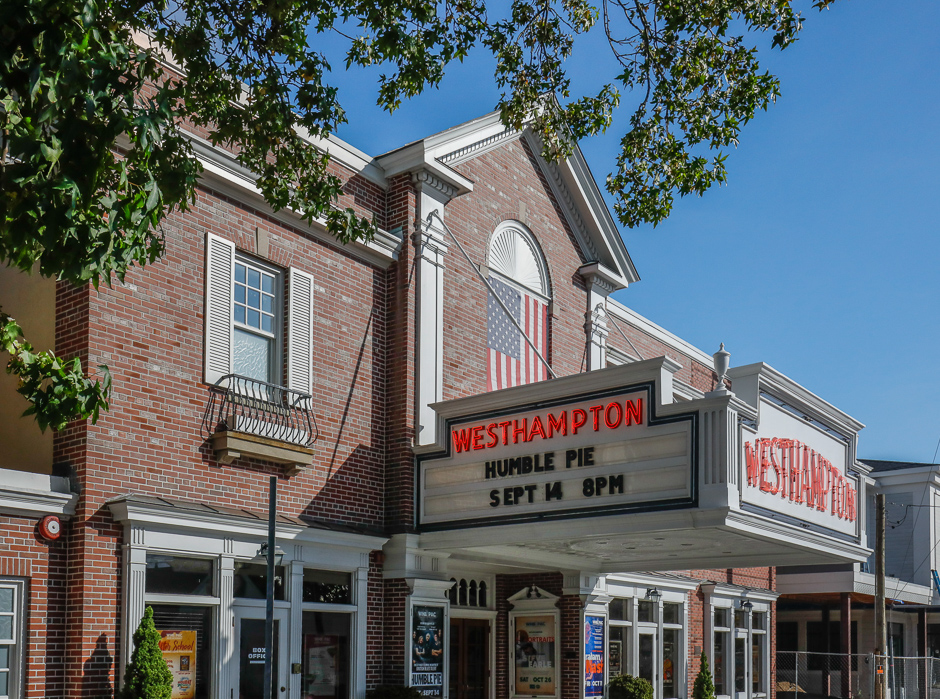
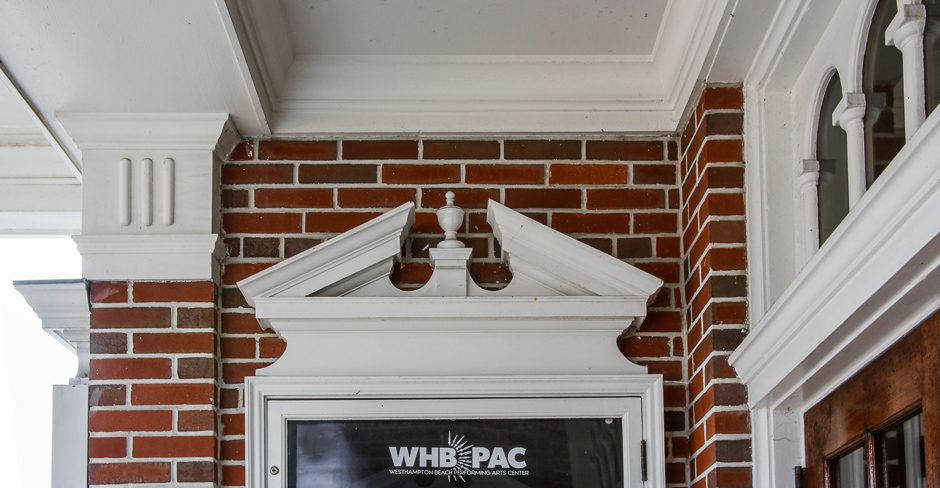
~~~~~~~~~~~~~~~~~~~~~~~~~~~~~~~~~~~~~~~~~

Former Speeds Drugstore
This building, constructed in 1933 by the Heelbarp Corporation for Bob Green, was purchased by Morris Speed in 1938. Mr. Speed operated a drugstore here from May 1939 to 2000. — WHB Historical Society.
————————–
>>>>> Short Excursion up Sunset Road >>>>>

Former Barber and Beauty Shop
Former Dominic and “Ria” Del Bene Barber and Beauty Shop. This building, constructed circa 1900 on Main Street and moved to its current location by the Del Benes in 1932 is now a studio for the WHB Performing Arts Center. The Del Benes’ lived in a house behind the shop. Following Ria’s death in 2006 both buildings were acquired by the WHB PAC, although renovated the buildings retain their early 20th Century character. — WHB Historical Society.
~~~~~~~~~~~~~~~~~~~~~~~~~~~~~~~~~~~~~~~~~

This building, likely constructed circa 1920 when Sunset Avenue was opened, illustrates the frequent conversion of an historic family home to a business purpose, thus preserving the historic building and the appearance of the Village. — WHB Historical Society.
~~~~~~~~~~~~~~~~~~~~~~~~~~~~~~~~~~~~~~~~~
<<<<< Return to Main Street / North Side >>>>>

The Patio Building
This building, constructed in 1931 by the Heelbarp Corporation, strongly resembles Speeds. The building is large, fronting both Sunset Avenue and Main Street, and was originally owned by Jesse and Milton Weixelbaum and Hermon F. Bishop. It was for many years “the only restaurant in town” and featured large dining areas and a dance floor. In the mid-1970s, it became condominiums and now houses businesses and apartments. — WHB Historical Society.
~~~~~~~~~~~~~~~~~~~~~~~~~~~~~~~~~~~~~~~~~
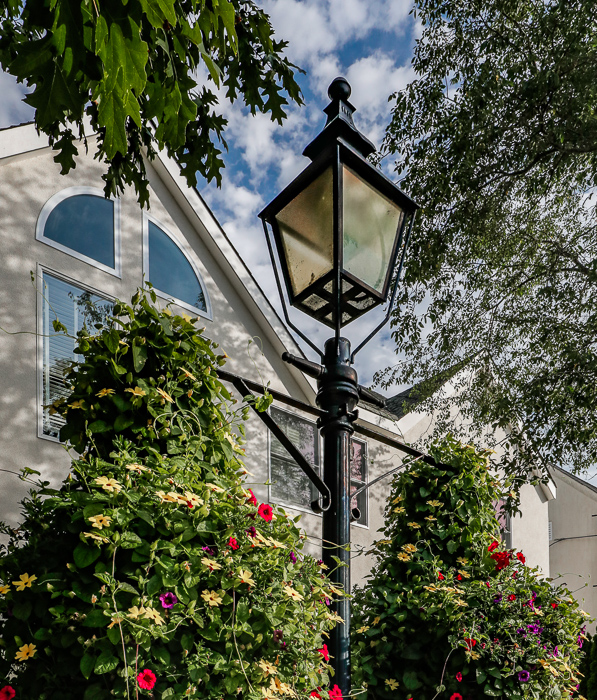
~~~~~~~~~~~~~~~~~~~~~~~~~~~~~~~~~~~~~~~~~
AAQ Resource: Brian J. Mahoney, Landscape Architect, 48-D Main Street / Link
~~~~~~~~~~~~~~~~~~~~~~~~~~~~~~~~~~~~~~~~~
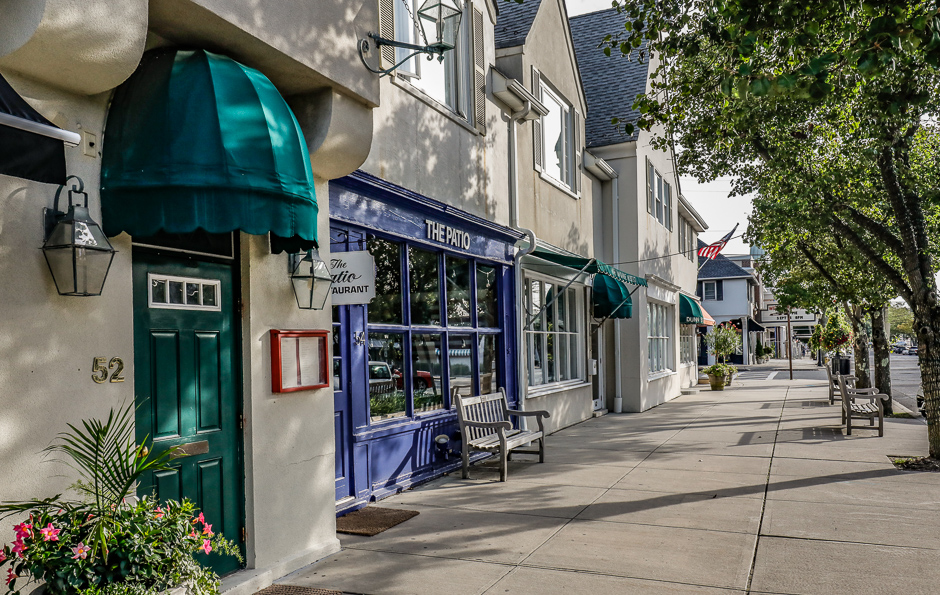
Patio Building on left, looking towards former Speeds Drug Store & former Main Street Theater.
~~~~~~~~~~~~~~~~~~~~~~~~~~~~~~~~~~~~~~~~~
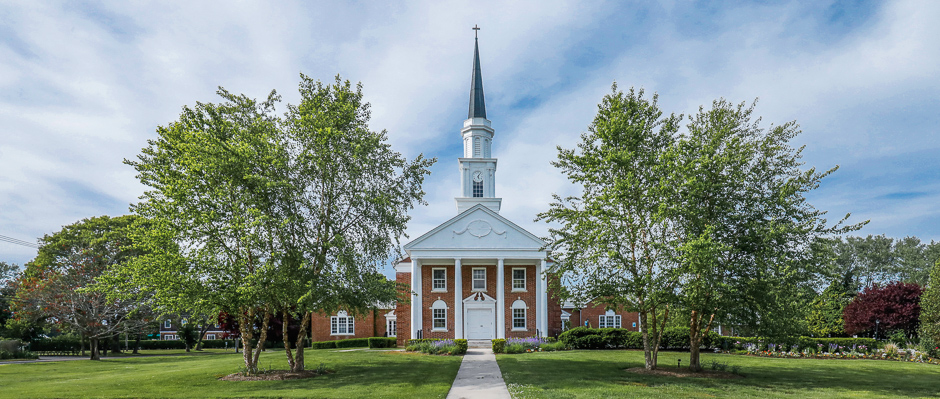
St. Mark’s Church located at west end of Main Street.
_____________________________________________________________________________
South to North Main Street / East Side
~~~~~~~~~~~~~~~~~~~~~~~~~~~~~~~~~~~~~~~~~

Former Mitchell Stevens Home
Mitchell Stevens was a descendent of one of the Village’s founding families. Constructed in 1898, reportedly using a wing from the original circa 1735 Stevens Homestead, and acquired by Dr. Seth Jagger in the 1920s for use as his home and doctor’s office, it was most recently used as a bank. Some original aspects of the house, including gherkin-style rooflines and Yankee gutters, remain discernible beneath the many additions. — WHB Historical Society.
~~~~~~~~~~~~~~~~~~~~~~~~~~~~~~~~~~~~~~~~~
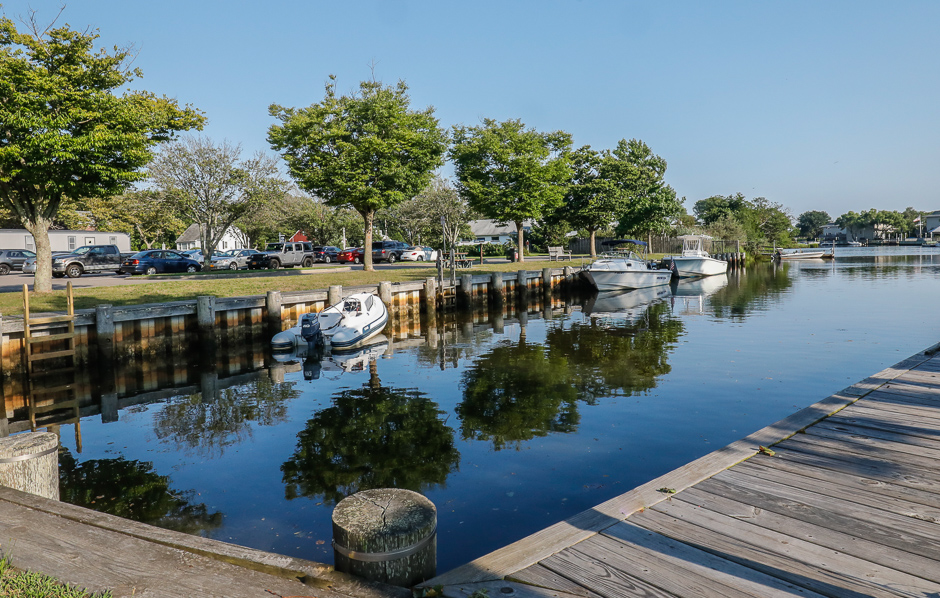
Boat docking area off Hulse Court (off Moniebogue Lane)
~~~~~~~~~~~~~~~~~~~~~~~~~~~~~~~~~~~~~~~~~
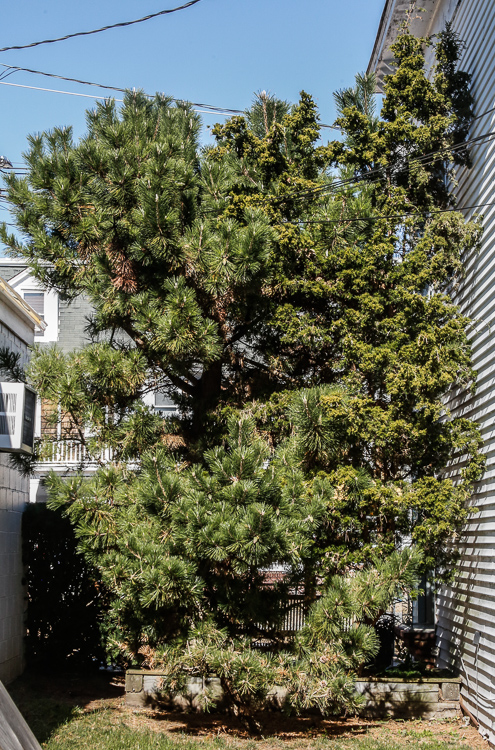
Pitch Pine
This particular tree is a “volunteer” — no human planted it, but a seed or cone was possibly buried by a squirrel and a little seedling took root and thrived. Westhampton Beach Tree Walk*
~~~~~~~~~~~~~~~~~~~~~~~~~~~~~~~~~~~~~~~~~
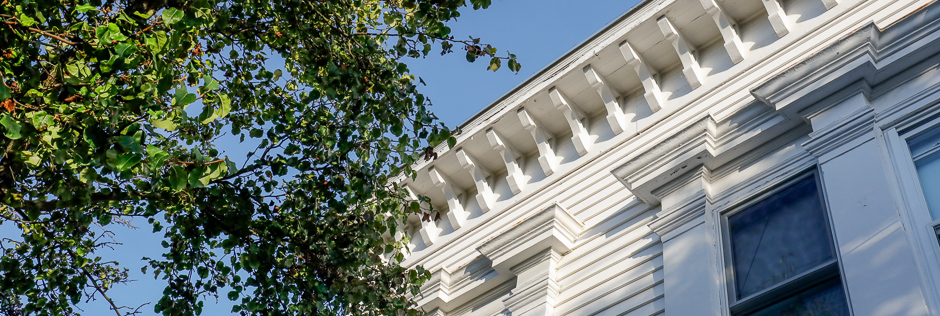

Winters Building
Constructed in the early 1900s and home to a variety of businesses over the years, including William Winters’ real estate business. Although both the exterior and interior of the building have been updated, some distinctive architectural features have been retained as a link to the building’s past. — WHB Historical Society.

~~~~~~~~~~~~~~~~~~~~~~~~~~~~~~~~~~~~~~~~~
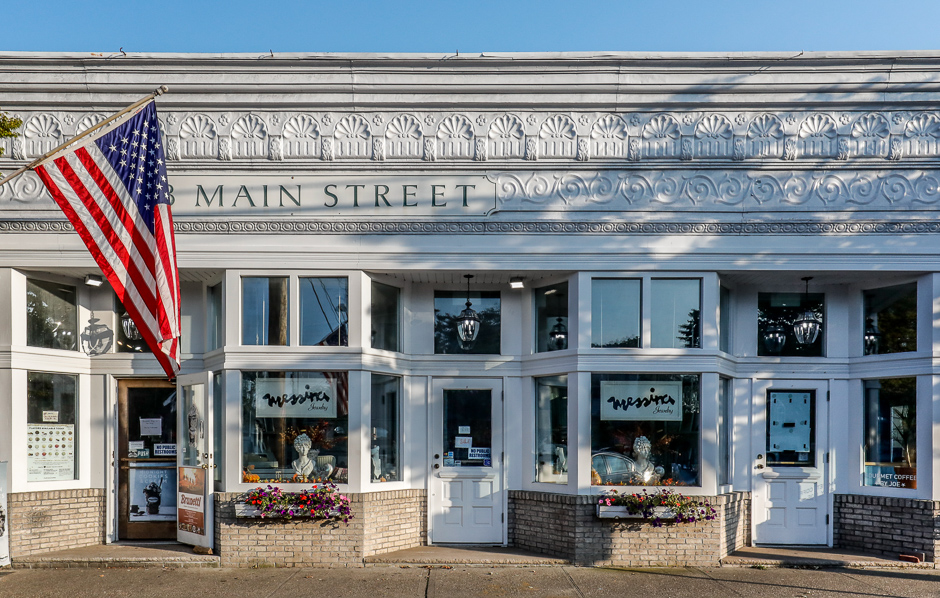
Weixelbaum Building
Constructed in 1895, this building was purchased about 1902 by Moses Weixelbaum after he emigrated from Germany and has housed several grocery stores, including Weixelbaums, Royal Scarlett, W. Heins Meat Market, and the Westhampton Quogue Market. Although modernized, this building exhibits many architectural features, including recessed doorways, trim and decorative panels, that hint at its history.
—` WHB Historical Society.

~~~~~~~~~~~~~~~~~~~~~~~~~~~~~~~~~~~~~~~~~
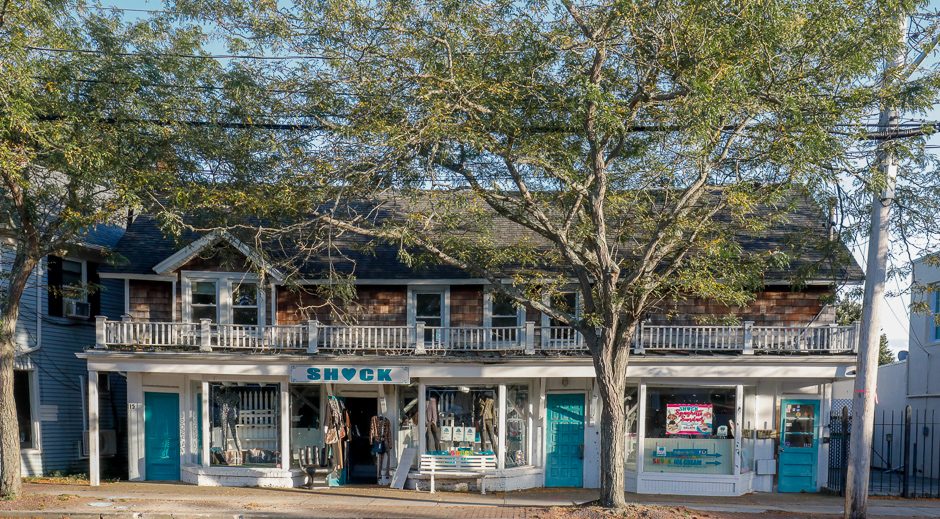
Platt Building
The Platt Building is one of the oldest buildings in the Village. Likely built by Hugo Schramm in the mid-1890s and then sold to Henry Platt, this building has been home to clothing stores, Western Union, Swezey ad Newins, and until recently, Magic’s Pub and the Artful Dodger. In 1925 John King moved the printing presses and linotypes of the Hampton Chronicle into the east end of this building, where they remained in operation until 1957. It appears that very little has changed the appearance of this building, which still retains its wood-shingled exterior, porch railings, and recessed doorways. — WHB Historical Society. Note: This building was demolished in September, 2019.
============================ FLASH FORWARD / SEPTEMBER 30, 2019 ============================
 Photo courtesy of Elyse Richman / SHOCK WESTHAMPTON
Photo courtesy of Elyse Richman / SHOCK WESTHAMPTON
Visit: Westhampton Beach Main Street Reconstruction

============================FLASH BACK TO SEPTEMBER 2019============================
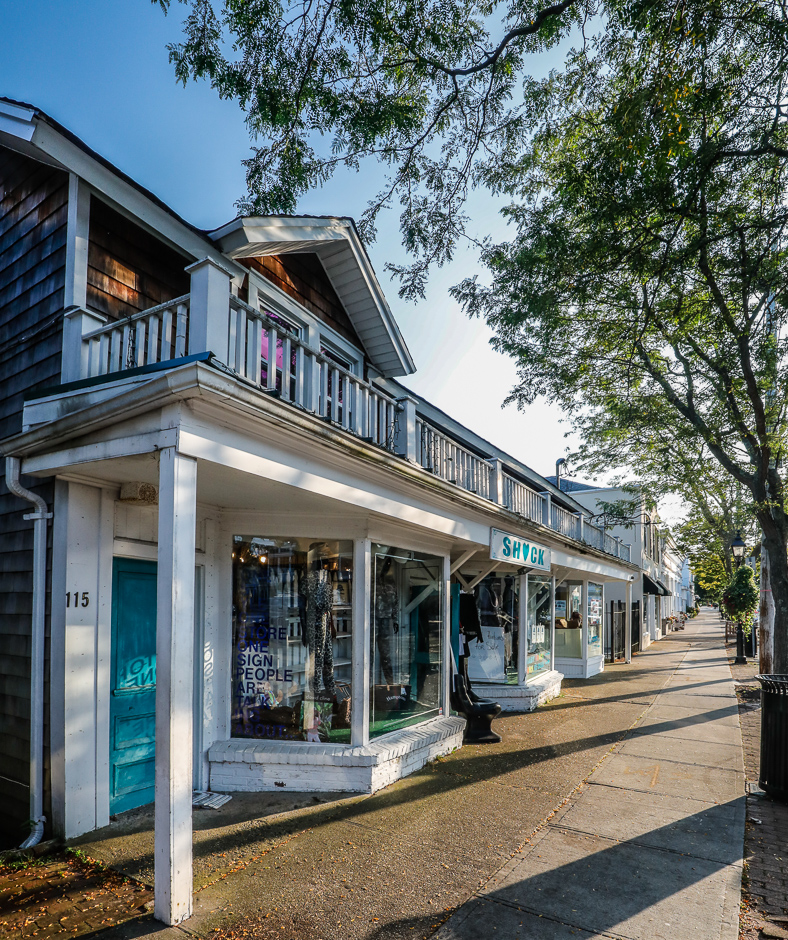
~~~~~~~~~~~~~~~~~~~~~~~~~~~~~~~~~~~~~~~~~
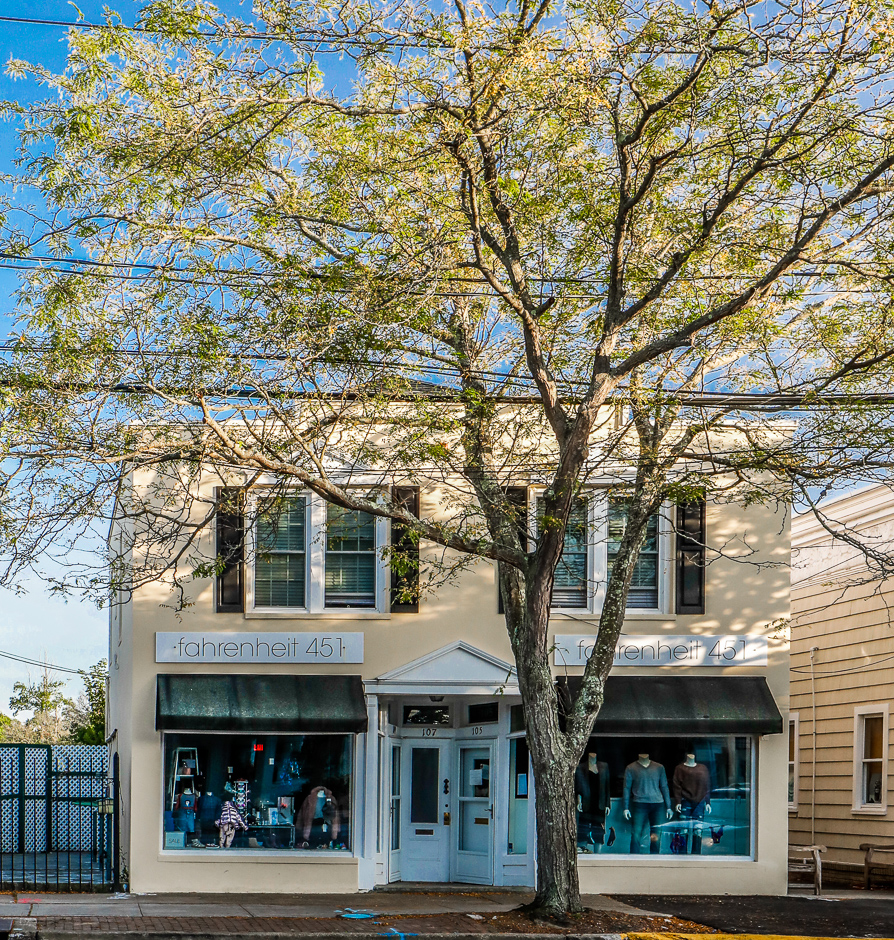
Platt Building for A&P.
Constructed circa 1921 by Henry Platt for the A&P Grocery Store, which operated here for about 10 years. Gelston Walter purchased A&P’s stock when the store closed and continued operating as Walter’s Market for many years. Later Victor Dayton’s Market occupied this building. — WHB Historical Society.
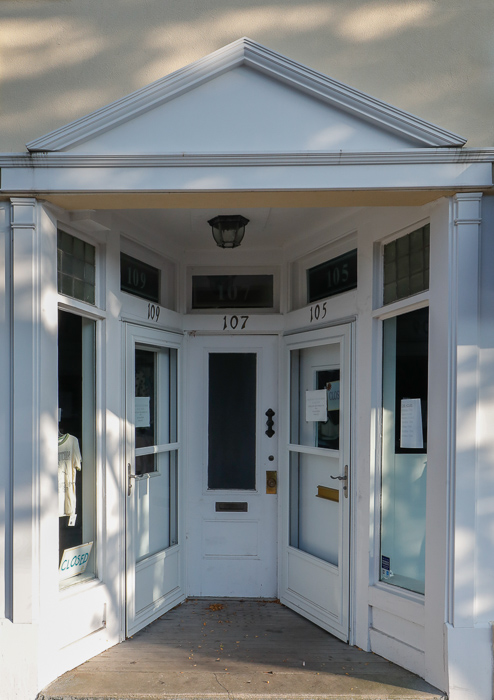
~~~~~~~~~~~~~~~~~~~~~~~~~~~~~~~~~~~~~~~~~

Owens Building
Constructed by Ben Owens in 1909, it operated as a plumbing shop out of the east side until the 1960s when the business was purchased by Hallock Culver. The west side was initially operated by Herbert Wimpfheimer as a butcher shop until 1917 when it became the Roulston Food store. Many other tenants have occupied this versatile building over time. — WHB Historical Society.
~~~~~~~~~~~~~~~~~~~~~~~~~~~~~~~~~~~~~~~~~
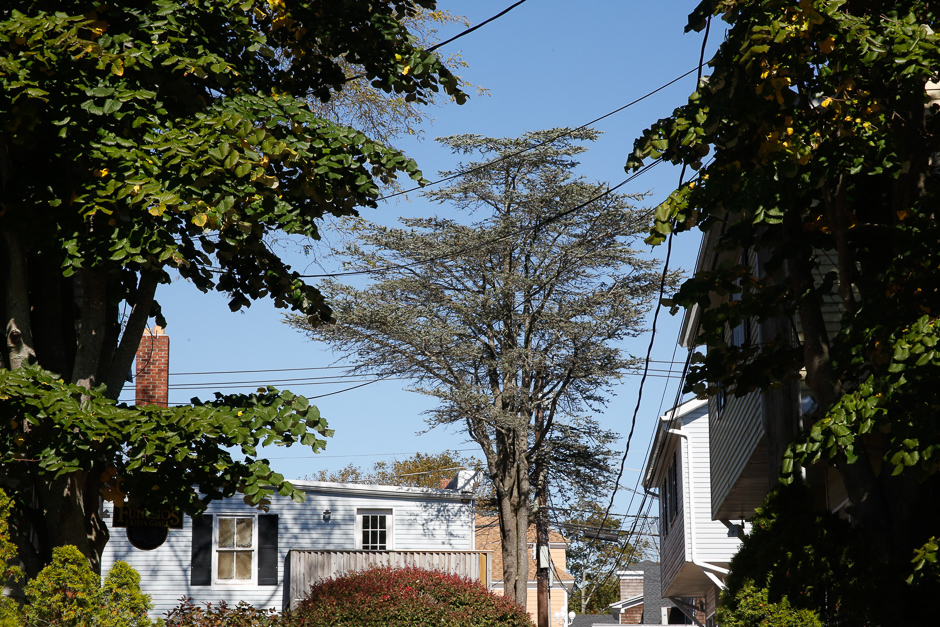
Blue Atlas Cedar
This beautiful silvery-blue evergreen has light brown cones, 2-3 inches long, which eventually turn violet-purple. It has a gray, smooth bark for its first 25 years; after that it cracks and forms scales. Full-grown trees can reach 165 feet in height. —Westhampton Beach Tree Walk*
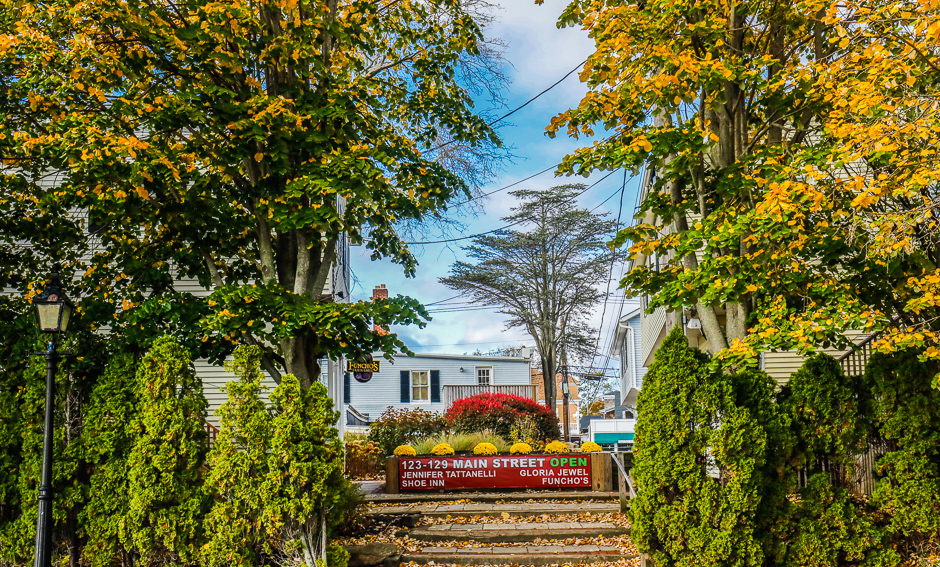
October 28, 2019
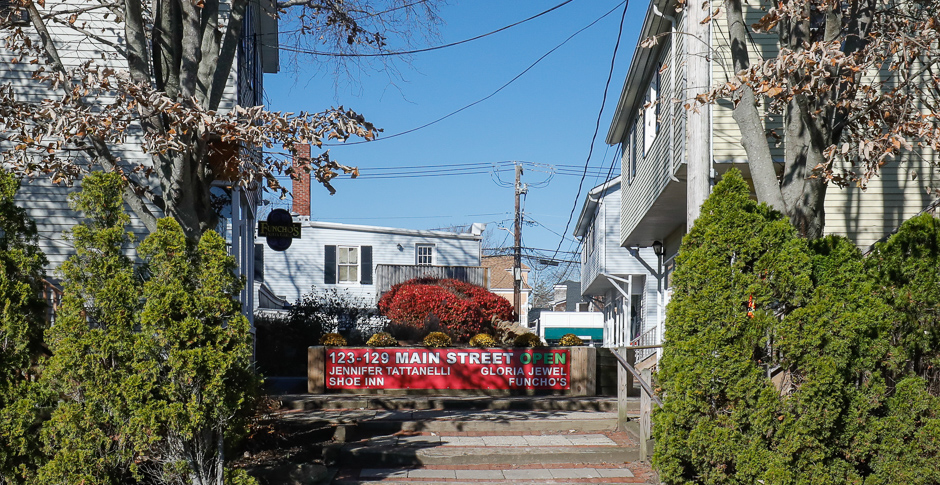
November 14, 2019
~~~~~~~~~~~~~~~~~~~~~~~~~~~~~~~~~~~~~~~~~
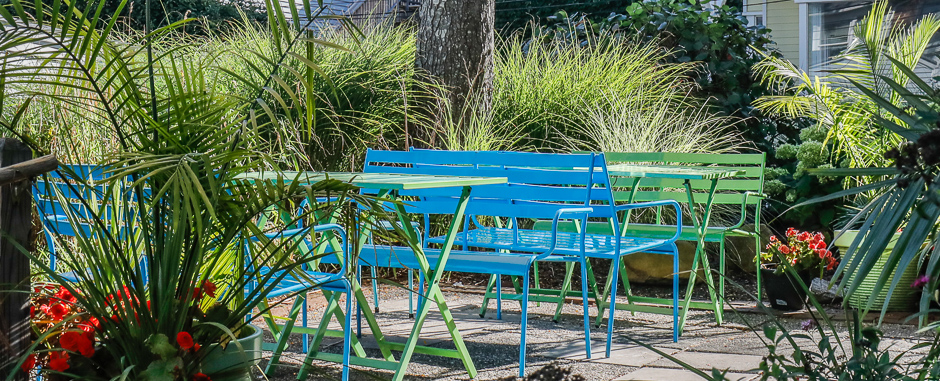
Dining off Main Street.
~~~~~~~~~~~~~~~~~~~~~~~~~~~~~~~~~~~~~~~~~
>>>>> Short Excursion up Library Avenue >>>>>
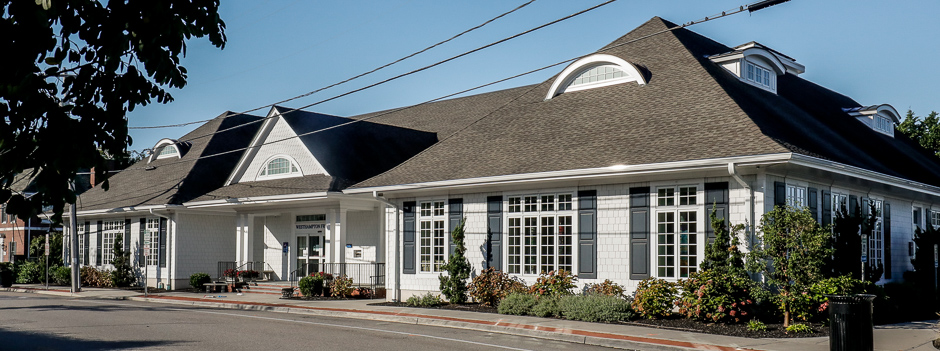
Westhampton Free Library, Library Avenue
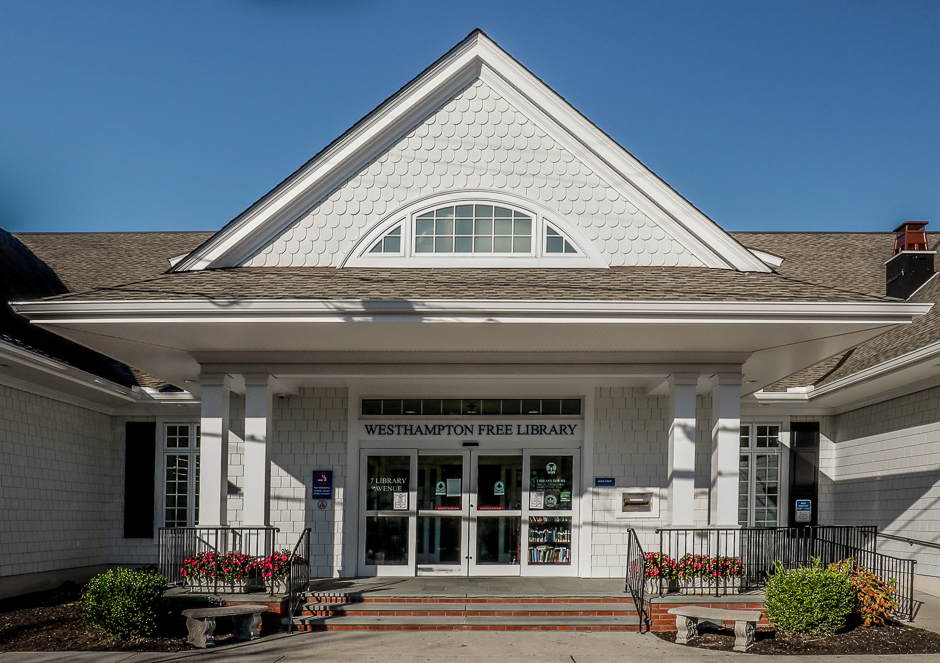

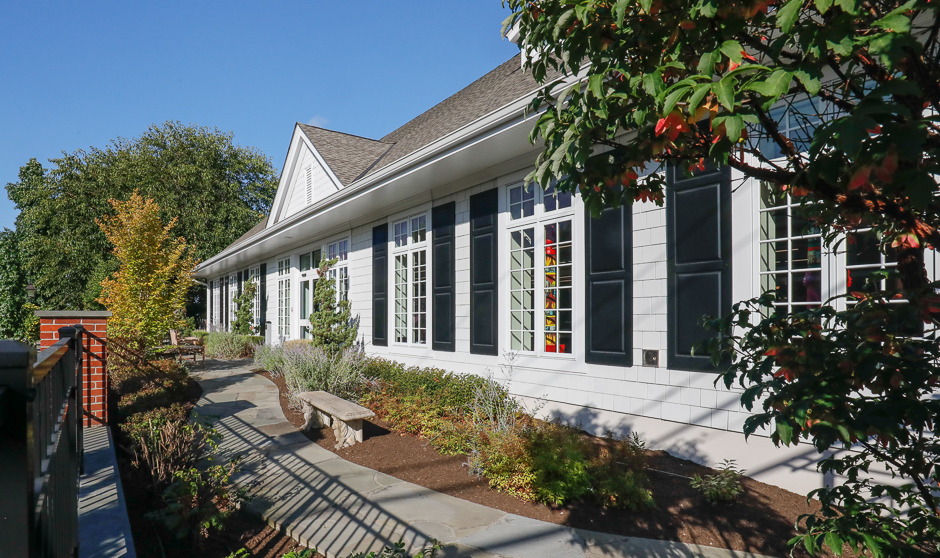
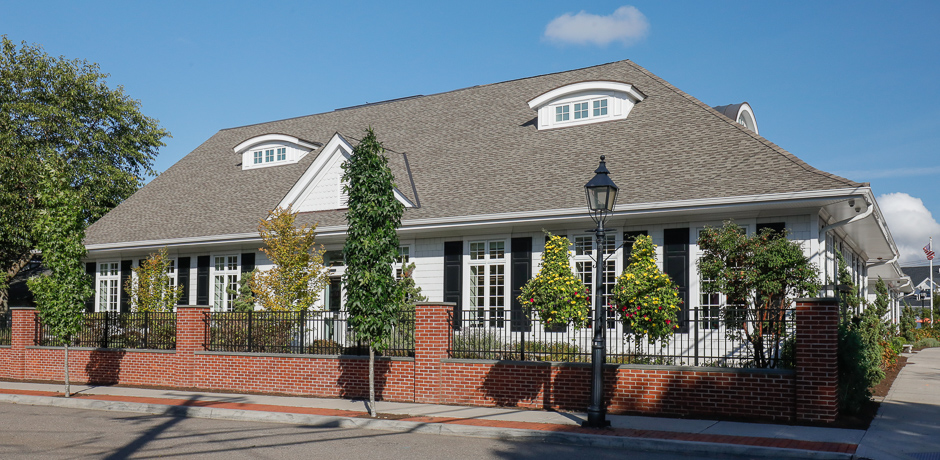
~~~~~~~~~~~~~~~~~~~~~~~~~~~~~~~~~~~~~~~~~
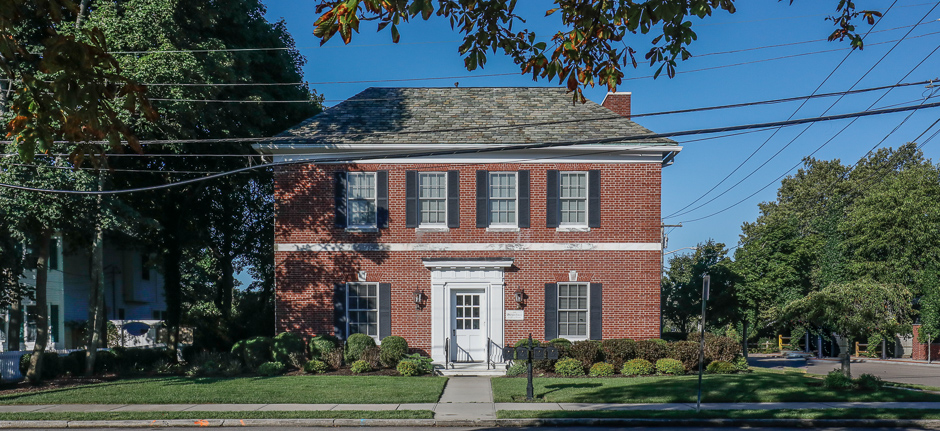
Former Telephone Building
Constructed around 1930, it was occupied by a switchboard that handled all telephone subscribers in the Westhampton area, which amounted to 875 in 1940 and 1,200 by 1949. This building was converted to apartments after switchboards became obsolete. — WHB Historical Society.
<<<<< Return to Main Street / South Side >>>>>

Former Bohack’s Store
Brick building originally constructed in 1949 as a grocery store for Bohack’s, then occupied by Gristides, and now used as a Rite Aid Store. — WHB Historical Society.
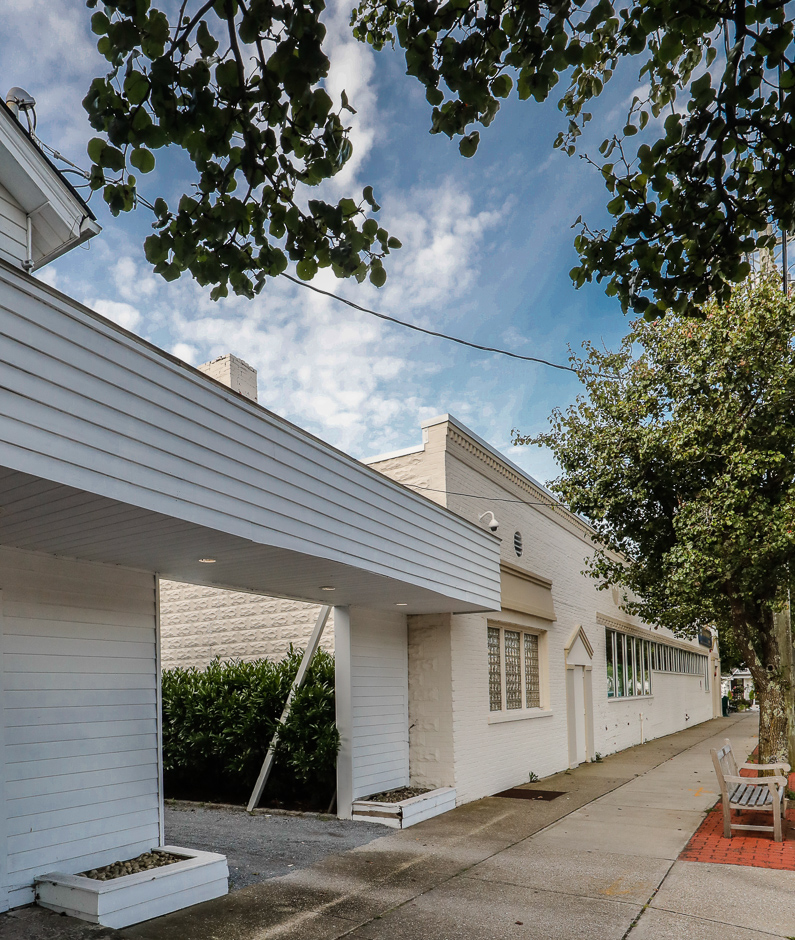
~~~~~~~~~~~~~~~~~~~~~~~~~~~~~~~~~~~~~~~~~

Dahl / Perry Building
Constructed circa 1902 at the former site of Raynor & Bishop’s General Store (1880 – 1902), this building was operated as a pharmacy and soda fountain starting in about 1916, first by Miss Dahl and her father and later by George Perry. Mr. Sheeley purchased the building in 1943 and continued operating as Sheeley’s Drug Store and Luncheonette until the late 1900s. The families who operated the pharmacies lived above the store. Although the building has been considerably modernized, it retains sufficient original architecture that its former family retail and residential use can be discerned. Of note, this was the site of the first official post office in the Village, which occupied a corner of the Raynor & Bishop store in the late 1800s. Prior to that time all mail was delivered to the original settlement at Beaver Dam. In later years the post office was moved to several other buildings until the current post office building was constructed in 1840. — WHB Historical Society.
——————————
>>>>>>>>>>>>>>>> Mill Road to Westhampton Beach Village Hall >>>>>>>>>>>>>>>>>

Westhampton Beach Village Green w/ An English Garden By The Sea — Maintained by Westhampton Garden Club since 1965. WCC founded 1928.
~~~~~~~~~~~~~~~~~~~~~~~~~~~~~~~~~~~~~~~~~

~~~~~~~~~~~~~~~~~~~~~~~~~~~~~~~~~~~~~~~~~
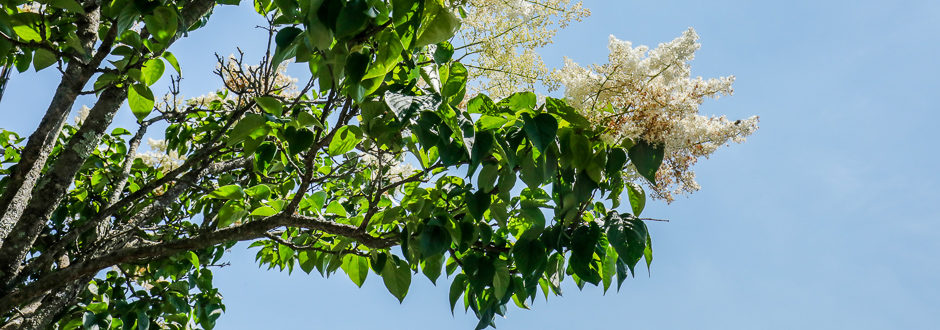
Japanese Tree Lilac
Native to Japan, this is the largest species of lilac and the only one that regularly makes a small tree rather than a shrub. Its best ornamental feature is its showy large plumes of feathery white blooms, which contrast well in summer with its dark green foliage. The flowers have a strong privet-like fragrance. The bark is reddish brown and peels on younger branches. — Westhampton Beach Tree Walk*
~~~~~~~~~~~~~~~~~~~~~~~~~~~~~~~~~~~~~~~~~

Bus Stop Shelter, Suffolk County Transit, Westhampton Beach
~~~~~~~~~~~~~~~~~~~~~~~~~~~~~~~~~~~~~~~~~
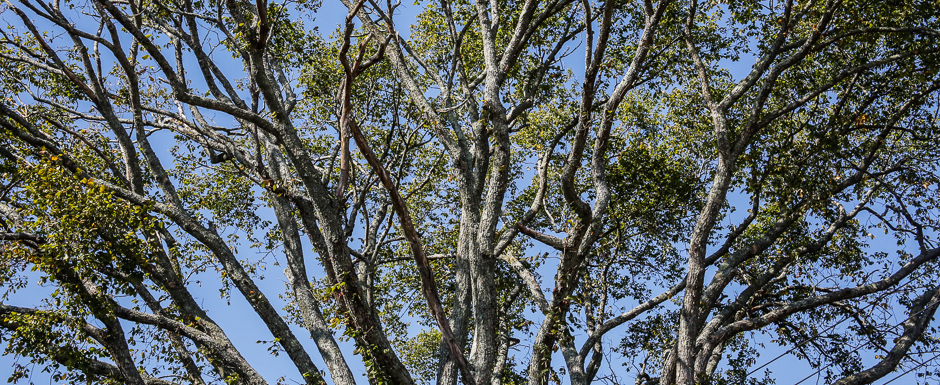
American Elm / details.
Its characteristic vase-shaped form looks like a geyser of branches exploding out of the earth. This tree once flouished all over the eastern United States, but has been decimated by Dutch Elm Disease. This is the only Village-owned elm left. It is being treated every three years to prolong its life. — Westhampton Beach Tree Walk*


~~~~~~~~~~~~~~~~~~~~~~~~~~~~~~~~~~~~~~~~~
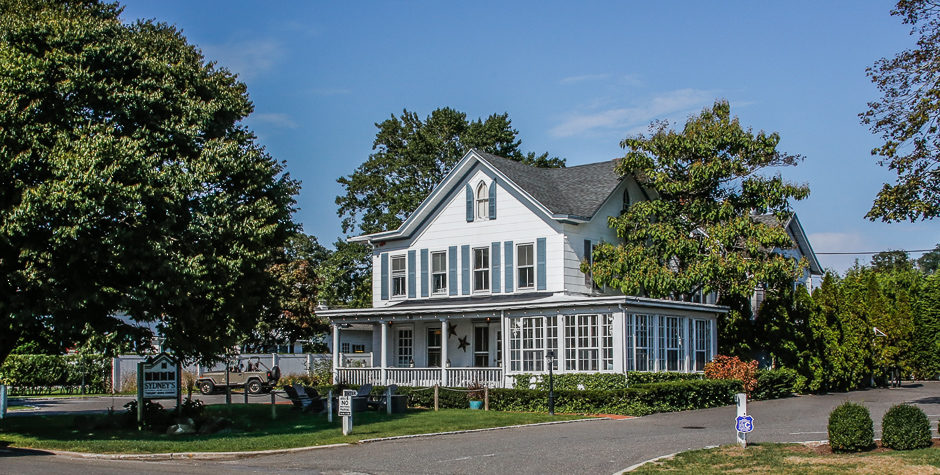
Former Henry Howell and Florence Sistare (Pitt) Home
Constructed circa 1907, when Henry and Florence were married, the home was associated with the Howell House, a boarding house operated since 1868 by Henry’s father, Mortimer Howell, and formerly located just to the east. Henry Howell operated the boarding house, starting in 1901 after his father’s retirement, and Florence joined him in this endeavor until 1926 when the boarding house was sold. The boarding house was demolished in 1970, but this historic Howell home survives. Previously occupied by serval businessess, it is now a cafe. — WHB Historical Society
~~~~~~~~~~~~~~~~~~~~~~~~~~~~~~~~~~~~~~~~~

Bell Tower of the Beach Methodist Church
~~~~~~~~~~~~~~~~~~~~~~~~~~~~~~~~~~~~~~~~~

Commercial Building
Although little is known about the history of this very small building, its construction is typical of commercial buildings on Mill Road, probably the oldest street in the Village, which is aligned diagonally relative to other streets. To provide maximal floor space on the non-rectangular lots adjoining Mill Road, many of the buildings feature storefronts that are parallelograms, rather than rectangles. The Yankee gutters on this building suggest early 1900s construction, although a 1917 map of the Village does not show this building. — WHB Historical Society.
~~~~~~~~~~~~~~~~~~~~~~~~~~~~~~~~~~~~~~~~~
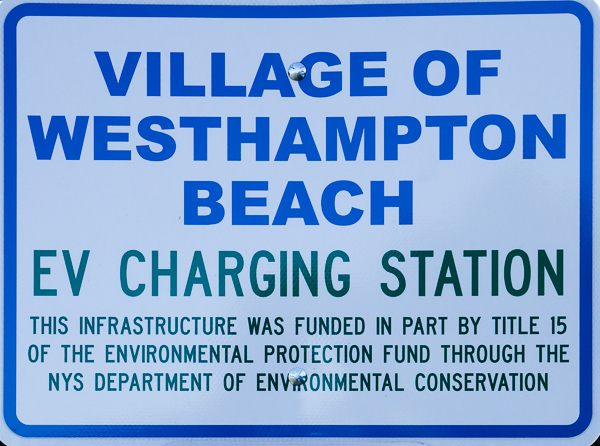
Charging Station at parking lot close to Foster-Meeker House.
~~~~~~~~~~~~~~~~~~~~~~~~~~~~~~~~~~~~~~~~~

Foster-Meeker House, 1735, Westhampton Beach.
Future home of the Foster-Meeker Heritage Center.
The Foster-Meeker Heritage Center is a reconstruction of the oldest surviving building in Westhampton Beach, originally known as Ketchaponack. The area was initially settled in the 1730s after the original Southampton community expanded westward following the 1666 Quogue Purchase and 1683 land division. The original Foster-Meeker House, of which an extensive intact framing system remains, was constructed about 1735 and likely used by early settlers.
Architecturally, the Foster-Meeker House was significant as a mid-1700s post-and-beam Cape Cod-type dwelling. Characteristically low to the ground and compact in appearance, the Cape Cod dwelling expressed a unique response among early Long Island settlers to an exposed environment with high winter winds, hurricanes, and other natural coastal phenomena.
The Westhampton Beach Historical Society, recognizing that the Foster-Meeker House was one of the oldest structures in the Village, documented the building, secured funding, and moved the House to its current location when it was threatened with demolition in 2008. — Westhampton Beach Historical Society.
New York State & National Register of Historic Places
~~~~~~~~~~~~~~~~~~~~~~~~~~~~~~~~~~~~~~~~~
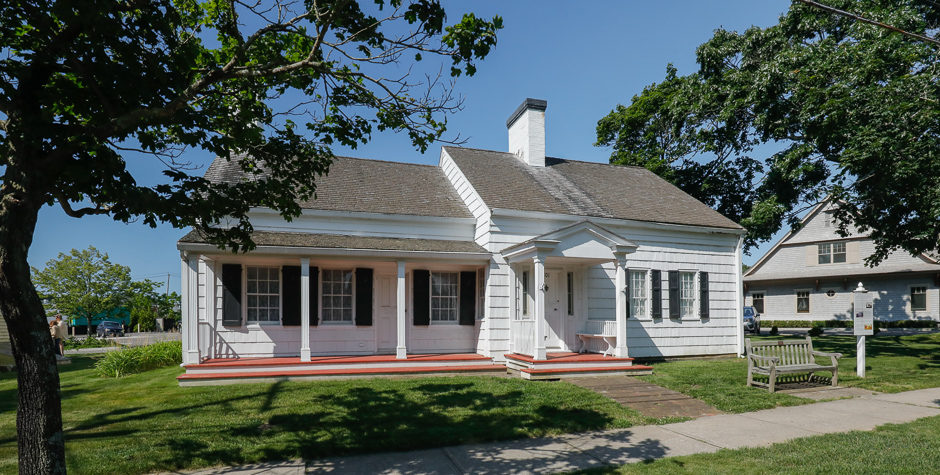
Josiah Tuthill House, 1840, Remsenburg, later moved to Westhampton Beach.
The house was built in 1840 by Josiah Tuthill. Josiah was a grandson of John Tuthill who came from Southold about 1760 to become a first settler of Speonk (later renamed Remsenburg).The house was originally located on South County Road, a wide avenue made truly beautiful by lovely Colonial and Victorian homes fronted by white picket fences and stately trees.
In the mid to late 1890’s the house served as the local post office and gathering spot, with Josiah Tuthill’s son, Gilbert, acting as Postmaster. In 1954 the house was sold and floated by bay to Quiogue, at a site on Foster Lane. In 1990, the house was donated to WHBHS. By 1991, the quaint old farmhouse was once again on the move—this time to its current site on Mill Road, Westhampton Beach.
With dedication, commitment and community support, the Westhampton Beach Historical Society opened the totally renovated house-museum to the public in 1995. — Westhampton Beach Historical Society.

~~~~~~~~~~~~~~~~~~~~~~~~~~~~~~~~~~~~~~~~~
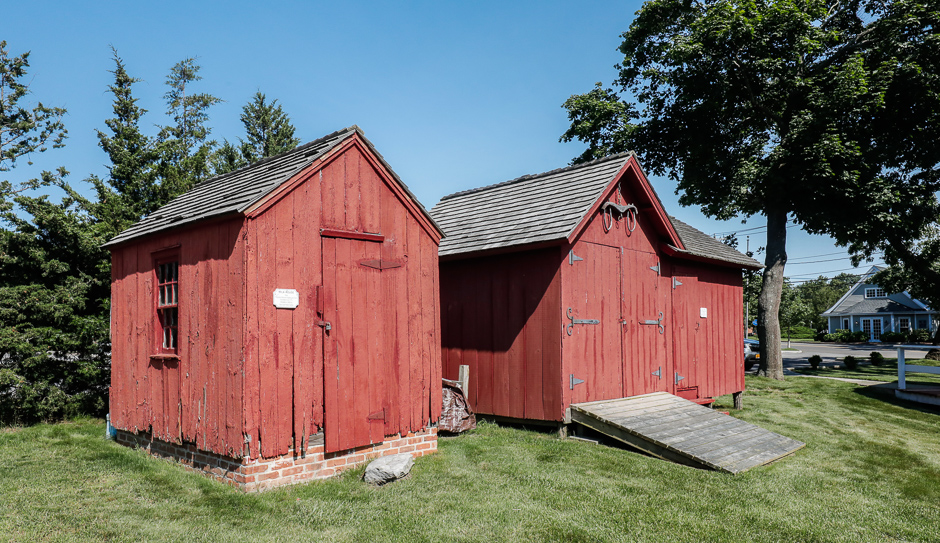
Foster – Meeker Carriage House and Privy, Circa 1850, foreground. Milk House from Thurston Raynor’s Apaucuck Farm, founded circa 1775. Construction of new Westhampton Beach Fire House, background.
~~~~~~~~~~~~~~~~~~~~~~~~~~~~~~~~~~~~~~~~~
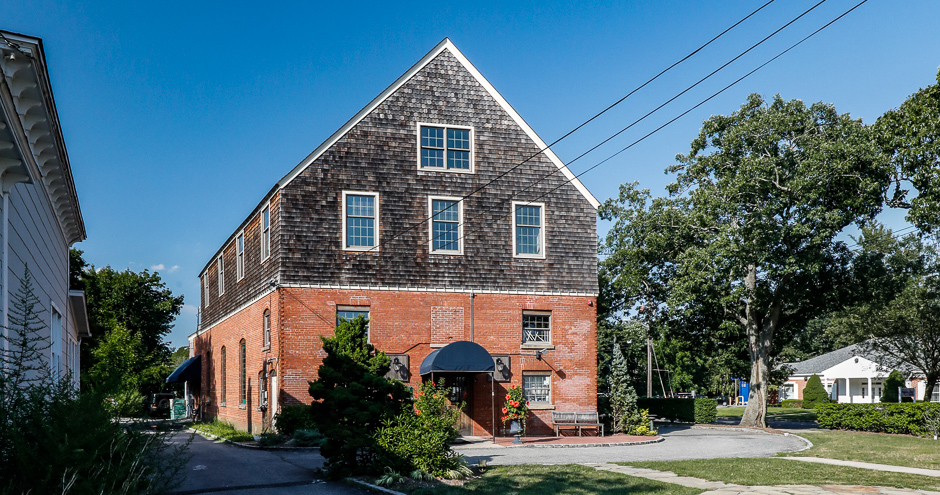
Mechanics Hall, 1906, Westhampton Beach
This building was constructed in 1906 by the Junior Order of American Mechanics for $ 7,000 and was used for many years as an assembly hall, hosting dances, meetings, movies, and theater productions. It was temporarily used as a school following the 1938 Hurricane, and during WWII it was the scene of many a meeting between servicemen and eligible young ladies. In recent years Mechanics Hall has been used as a nightclub and restaurant. — Westhampton Beach Historical Society.
~~~~~~~~~~~~~~~~~~~~~~~~~~~~~~~~~~~~~~~~~
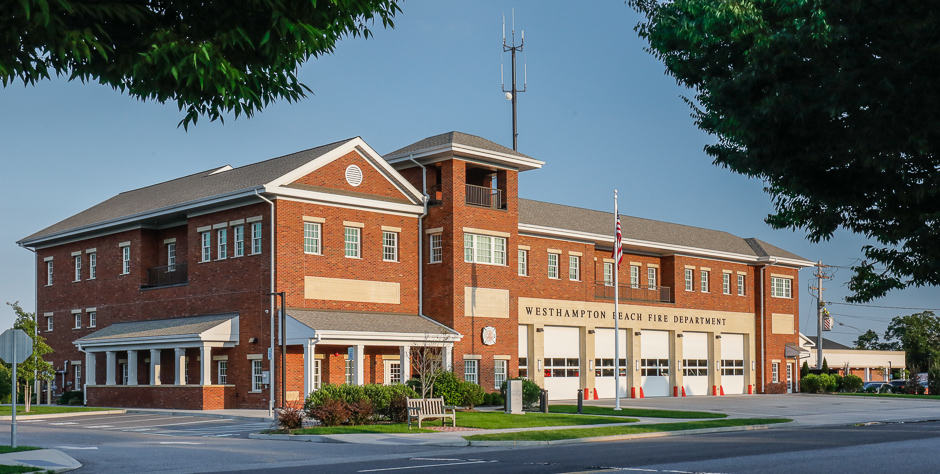
Westhampton Beach Fire Department, located on Sunset Avenue.
~~~~~~~~~~~~~~~~~~~~~~~~~~~~~~~~~~~~~~~~~
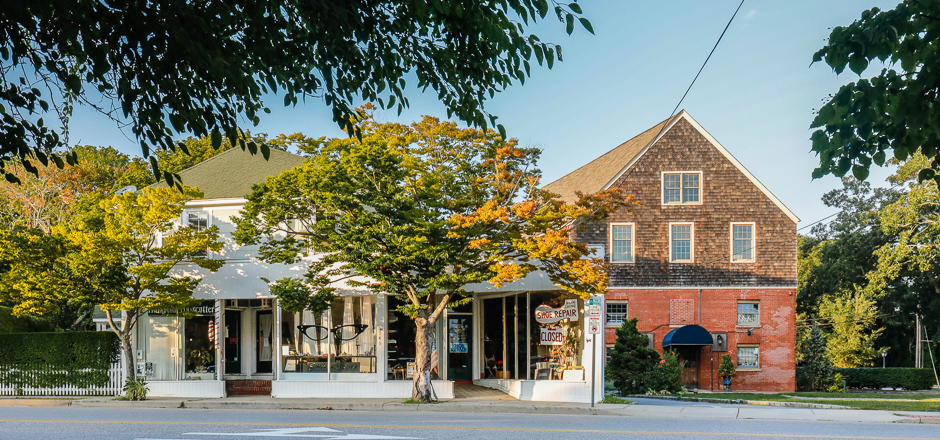
Former Gustav Herzog Bakery next to Mechanics Hall
Constructed around the turn of the century, this building originally housed Gustav Herzog’s bakery in the early 1900s. It was later expanded and converted to stores. — WHB Historical Society.
~~~~~~~~~~~~~~~~~~~~~~~~~~~~~~~~~~~~~~~~~

Eckarts Luncheonette
This building was originally “The Inside Out” a speakeasy founded in 1911 by Jacob Eckart. In 1949, following service in WWII, Warren “Red” Eckart took over the business, turning it into a luncheonette, which it remains today, now run by Red’s daughter, Dee Eckart McClain. — WHB Historical Society.
~~~~~~~~~~~~~~~~~~~~~~~~~~~~~~~~~~~~~~~~~
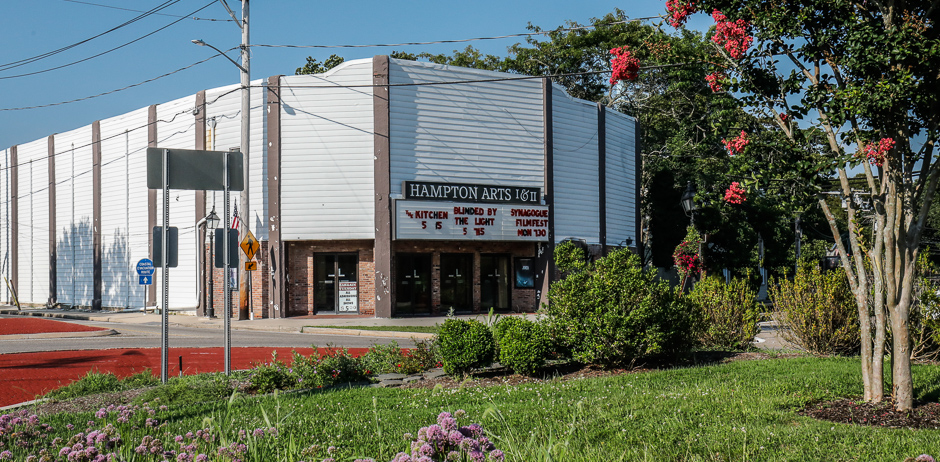
Hampton Arts Theater, 1947, Westhampton Beach.
Formerly the Hampton Star Theater (also known as the Westhampton Playhouse), it was constructed in 1927 by Harry Nugent and burned in 1932, unfortunately without fire insurance. It was rebuilt by Mr. Nugent and reopened in 1947. The original building included not only a theater, but the first Westhampton Beach Village office and a candy and ice cream business. Although the theater space has been divided, it remains an active movie venue. —– Westhampton Beach Historical Society.
~~~~~~~~~~~~~~~~~~~~~~~~~~~~~~~~~~~~~~~~~
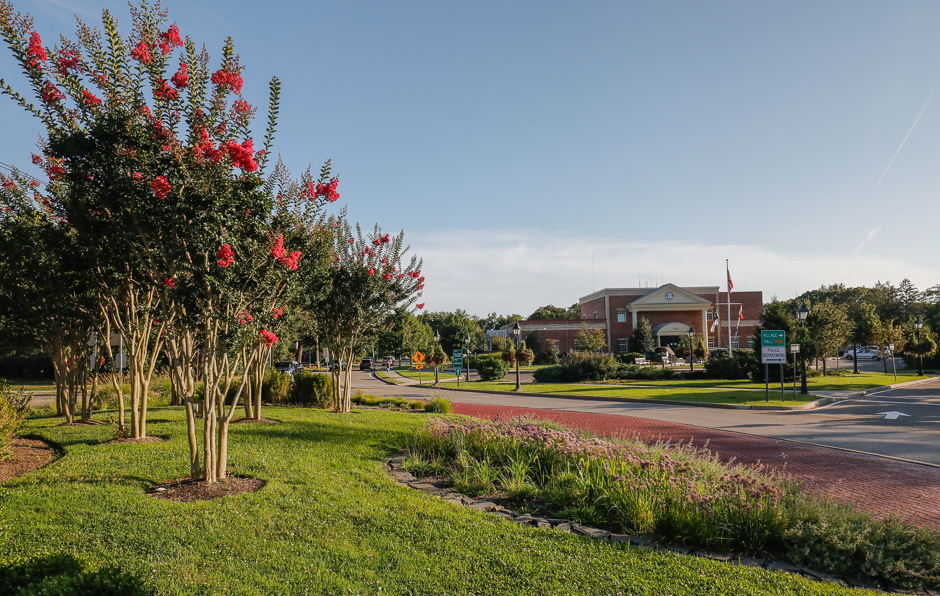
Crepe Myrtles in Blossom on Roundabout.

Westhampton Beach Village Hall

~~~~~~~~~~~~~~~~~~~~~~~~~~~~~~~~~~~~~~~~~
For a history of Westhampton Beach, please visit www.whbhistorical.org
Copy courtesy of the Westhampton Beach Historical Society.
————————-
- The Village of Westhampton Beach has been named a “Tree City USA” by the National Arbor Day Foundation every year since 1988. The Village is also the annual recipient of a “Tree City USA Growth Award” for demonstrating progress in its community forestry program in the areas of tree inventory and analysis and development of a computerized tree-management system. — The Westhampton Beach Tree Walk brochure.
~~~~~~~~~~~~~~~~~~~~~~~~~~~~~~~~~
View Westhampton Beach Main Street Reconstruction / In Progress
——————
Photographs © Jeff Heatley.
___________________________________________________________
